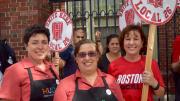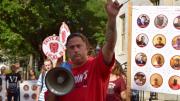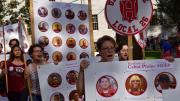Harvard might soon find itself dealing with its largest labor battle in more than a decade, when in 2002 its lowest-paid workers fought for, and won, the right to earn a living wage. Yesterday, the University’s dining hall workers voted 591-18 to authorize a strike, following nearly four months of tense contract negotiations between Harvard and UNITE HERE Local 26, the union that represents the 750-person dining staff. The negotiations will enter federal mediation on September 27; the union plans to strike if a resolution is not reached by September 30. At the center of the union’s demands is a $35,000 minimum salary for employees willing to work full-time (currently, 48 percent of dining hall staff earn less). “Everything hinges on this right now,” said Brian Lang, president of Local 26.
The demand reflects a decades-long disagreement about the status of Harvard University Dining Services (HUDS) staff. Dining hall workers are seasonally employed, the University points out, because most students are away during the summer months and winter break. “Harvard’s dining hall workers currently receive highly competitive wages that lead the local and national workforce for comparable positions in the food-service industry, with the average dining hall worker earning $21.89 an hour,” University spokesperson Tania deLuzuriaga said in statement. Workers also receive retirement benefits and health insurance far more generous than those offered in the commercial food service industry, she added. But because dining hall employees don’t work year-round, incomes are still low: on average, the workers make just less than $34,000, which, according to the MIT Living Wage Calculator, is not enough to support a household of more than one person in the Boston area. Many of the employees work overtime or find temporary jobs elsewhere during the summer to supplement their income, but, the union argues, they shouldn’t have to.
Implicit in the union’s demand for a $35,000 salary are opportunities for HUDS employees to work during the summer months, so that they can work a full-time schedule (defined as 2,087 hours per year) without having to work overtime. Harvard has collaborated with the union to provide such opportunities in the past, but with limited success. Meeting this demand would likely require significant changes in Harvard’s labor structure—which is perhaps what the union wants. At Yale, for example, dining hall staff belong to the same union as workers in other trades, and are able to work year-round by switching among duties. At Harvard, dining hall staff have their own union. (Other universities avoid this challenge by outsourcing dining services to private contractors. But given the centrality of residential life to the Harvard undergraduate experience, the University values a direct relationship with HUDS.)
As the union and its supporters in the Harvard community stress the University’s obligations to its workers, administrators focus on the institution’s finances in an era of seeming modest endowment returns, pressure on other revenue sources, and rising costs in general. It certainly wasn’t a coincidence that Local 26 announced its intent to strike last week, just days after Harvard disclosed that its capital campaign had already raised more than $7 billion, surpassing its goal of $6.5 billion. The endowment, which reached its highest-ever nominal value of $37.6 billion last year, has been central to Local 26’s messaging: “Harvard has broken all fundraising records in the last few years,” Brian Lang said. “In that context, what we’re asking for is small change.” The University, naturally, views its fundraising and endowment resources very differently: “The Harvard Campaign seeks to raise funds around priorities related to the University’s core mission of teaching and learning,” deLuzuriaga said. “In addition, fundraising campaigns by their nature are long-range undertakings in terms of both vision and benefits. The current total includes both gifts and longer-term pledges that are paid over many years; many of these contributions are restricted, invested in the endowment, and will be distributed over time.” And indeed Harvard’s fundraising zeal has come during a moment of lackluster returns on its endowment. Despite gifts secured in the course of the capital campaign, it appears that the value of the endowment, typically announced in early autumn, may have declined in the 2016 fiscal year; last week, MIT reported a nominal investment gain but a net decline in the value of its endowment after distributions for its operations.
University officials describe the union’s proposal for a minimum full-time salary and annual raises, which they say would amount to raises of 40 percent over the next five years, as unaffordable. In response, Harvard has offered a schedule of raises totaling 10 percent over five years. The final result likely will end up somewhere in the middle. Earlier this year, the University’s largest union, the Harvard Union of Clerical and Technical Workers (HUCTW), negotiated raises of about 3.4 percent annually during the three-year life of its new contract.
Alongside its basic income demand, Local 26’s grievances include the University’s proposed health plan, identical to the one that it had negotiated for HUCTW. The plan offered by Harvard would create a new health-care tier for employees earning less than $55,000 (by far the majority of HUDS workers), who would pay the least in monthly premiums. Under the current health-care plan, the lowest tier includes all workers earning less than $70,000, who contribute 15 percent of the cost of their premiums. The sub-$55,000 tier would contribute 13 percent. But Local 26 has rejected the plan because it would also raise copayments substantially: emergency room visits would increase from $40 to $100, and hospital inpatient and outpatient services would increase from no copay to $100. “For people living paycheck to paycheck, an increased copay is a big deal,” said Local 26 spokeswoman Tiffany Ten Eyck. “Workers are afraid higher copays will make taking their children to the doctor a difficult decision or an undue burden.”
According to the University, Local 26 hasn’t made any counter-proposals to the health plan. Union officials respond that Harvard has refused to provide information about health-care utilization that they’ve requested in order to design a plan. “It’s disingenuous to say, ‘We’ve made a proposal and we’re waiting for the union to counter-propose,’ while they won’t give us the information we need to know what’s going on,” said Lang.
Despite these challenges and the threat of a strike, Paul Curran, Harvard’s director of labor relations, said, “I’m optimistic that we can get a contract that’s affordable for the University and that satisfies most of the issues of Local 26.”
The debate over who should be responsible for paying for workers’ health care arose in 2014, when the University introduced deductibles and coinsurance in its plans for faculty and nonunionized staff members. (The plan the University has proposed for Local 26 does not include deductibles.) Nationally, the proportion of employers offering plans with deductibles has risen dramatically in the last decade, reflecting both rapid increases in medical costs and the view among economists that shifting more of the cost onto patients will encourage them to shop around for the best prices and, ultimately, bring down health-care spending. But research on such policies suggests that they haven’t worked very well, and instead have simply encouraged employees to use less health care, even when they need it.
Why have HUDS workers decided to strike now? Lang said that workers have been frustrated with conditions at Harvard for a long time and have simply decided that “enough is enough.” Whatever the precise motivations behind the vote, it appears, for the union, to be auspiciously timed. Students appear more willing now than in the past to view Harvard’s endowment as a tool for ameliorating equality. Ten Eyck confirmed this observation: “Across the campuses we’re seeing widespread student support for the workers that goes well beyond what we imagined,” she said. “Dining hall workers have always known Harvard students support them, but never in numbers so great and with such strong commitment.” The Harvard Crimson, whose editorial board tends to defer to the administration on labor issues, recently urged the student body to support HUDS workers: “[W]e will support HUDS and whatever course of action they pursue in this negotiation process.”
About 200 people attended the dining hall workers’ rally announcing the strike vote last week, according to The Crimson, and about 100 medical and dental students rallied for the union the next day. Darshali Vyas ’14, a second-year medical student and a member of the Racial Justice Coalition at Harvard Medical School, said her group was particularly drawn to the issue of health-care access. “This campaign relates directly to combating disparities in health care based on race and class. On average, HUDS workers make less than $35,000 annually. We now also know that more than half of HUDS workers identify as people of color—a level of diversity not reflected elsewhere at the University—and that many of these workers represent minority and immigrant families living in Boston,” she explained. “Protecting their access to affordable health-care coverage is intimately tied to racial justice and shows that the fight for health equity rages on within our own communities.”
In the event of a strike, University officials say they have a plan, to be announced later, to make sure students remain fed.












